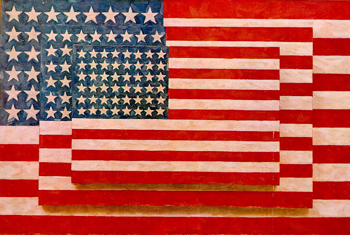
Three Flags

|
Three Flags has become an internationally-famous image, primarily due to its inclusion as a colorplate in H. W. Janson's renowned History of Art. Beyond that, though, it made waves when it was exhibited in 1958, and continues to resonate with viewers to this day.
Three Flags was created using a process Johns himself innovated: strips of newspaper are laid down, painted over, and then coated with a fast-drying, wax-based encaustic. This allowed Johns to overlay stokes in quick succession while still keeping each one distinct. Johns's stated method of Take an object / Do something to it / Do something else to it earned his work a reputation for being a Dada revival, and Three Flags is no exception. Its ambiguous nature echoes Dada in many ways: the piece could be a stinging satire or a respectful tribute, it could be simple-minded or infinitely complex. The piece is simultaneously simple yet thought-provoking, a quality common to many of his works.
The construction itself presents some interesting problems for the viewer to resolve. For one, the true flag of the image is unclear. From one perspective, the largest flag seems to be the source, with the two smaller flags built up on top of it, obscuring our view. From another perspective, the smallest flag appears to be the origin, with the two larger flags being afterimages or enclosing frames.
Interestingly, in 1959, only one year after Three Flags was completed, Alaska and Hawaii were granted US statehood. The 48-star flag that was the subject of Three Flags was now obsolete, a historical curio. Three Flags, then, serves also as a document of a bygone era of American history.












